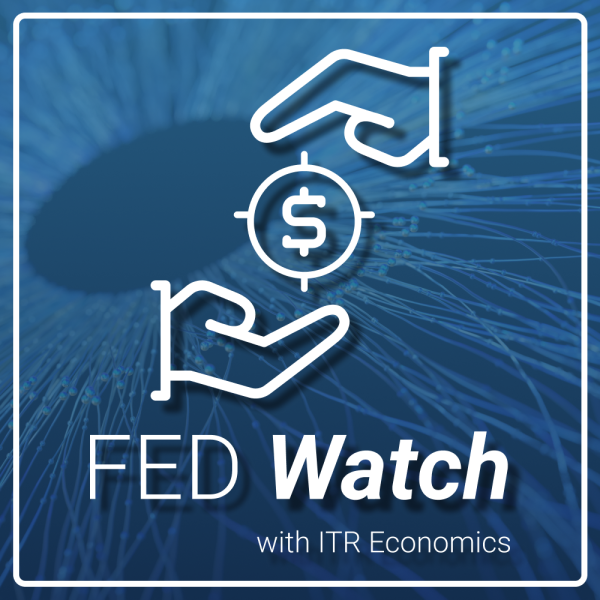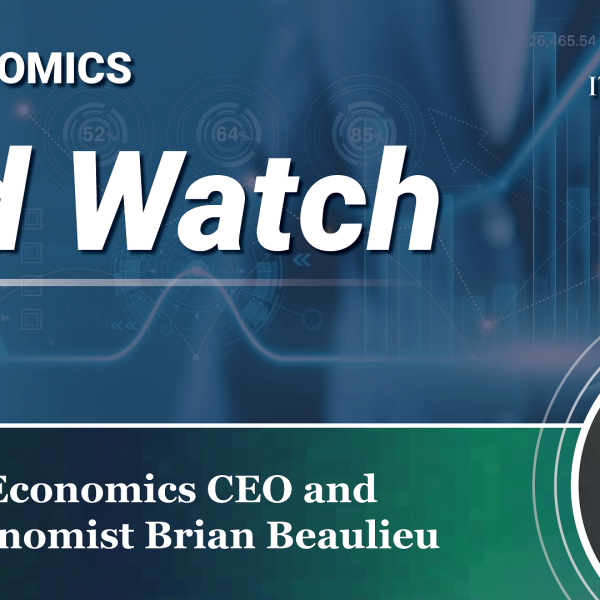- Mon - Fri: 8:30 - 5:00
- +1-603-796-2500
- ITR@itreconomics.com
with Brian Beaulieu
WEEKLY FED WATCH
This week on Fed Watch, ITR Chief Economist Brian Beaulieu reviews the latest economic and consumer data. Are consumer trends starting to slow the economy down? Tune in to find out!
Key Episode Takeaways
- 0:21 – New data on consumers shows the economy is losing momentum
- 0:57 – We will not rule out a September decline in the Fed funds rate
- 1:35 – Slowdown could lead to interest rate decline
- 1:47 – Reviewing Personal Consumption Expenditures (PCE) data
- 2:36 – Durable side of PCE remain negative, non-durables doing better
- 3:50 – Reviewing Real Personal Income data
- 4:47 – Reviewing the Personal Consumption Price Index data
- 5:34 – Subscribe to our new show – By the Numbers
The below transcript is a literal translation of the podcast audio that has been machine generated by Rev.
Hello. Welcome to this May 31, 2024 edition of Fed Watch. I’m Brian Beaulieu, Chief Economist, ITR Economics. There’s some interesting data that came out this month, and I’ll go through some of the highlights, but in summary, it shows an economy losing momentum. The consumer, in particular, is losing speed, in terms of being a consumer. Their incomes aren’t going up as much. In fact, the disposable personal income has really slowed to what amounts to a crawl, in terms of increasing. This is the bottom line already. All of which tells us that… I wouldn’t rule out a September decline in the Fed funds rate or other interest rates, for that matter. Although the market, looking at Fed funds rate futures, suggests that they’re really weighting it more heavily to beginning in 2025, but I wouldn’t rule out September, yet. It’s only about a 40% probability, based on the futures market, but I’m thinking it could be higher than that. Particularly since John Williams of the New York Fed recently said, “Inflation doesn’t have to be at 2.0 for the Fed to start cutting rates. They just need to see a path there.”
I think slowdown we’re about to talk about is that path that could allow those of us who would like to see an interest rate decline actually see it begin to happen. Personal consumption expenditures, PCE data came out, and you look at the total, that came in pretty good for the last three months. It’s up 5.2%, so that three 12 was up a couple of ticks from the prior two months. But as I say, the devil is in the details. When we looked at the April data compared to March, that month-to-month percent change was only personal consumption expenditures, were only up 0.2%, and that’s really quite low for our non-recession year. We get negative years like during Covid and during the Great Recession, and in 2000, negative month to month changes in those sorts of years. But to see only 0.2% is… It’s a wake-up call that things are slowing down.
Durable side of personal consumption expenditures remain negative, year over year. That data trend is in decline. Non-durables are doing better, but even there, we saw some weakness on that month-to-month basis, although that three month, when we total them, managed to hit a record high. The services, if you look at the year-over-year comps, they showed continued strength at 6.9% on a 3/12 rate of change. But there again, when we broke it down and looked at the March to April change, it was just barely normal. And the only reason the rates of change were as good as they were is because last year was even weaker than the rise this year. We may be seeing, Certainly on the good side of it, and maybe even on the services side of it, some pullback from the consumer, and they may actually need to do that, because we’re looking at savings that have actually dropped to 30.0% below a year ago level. That’s an amazingly stark decline, and with income slowing in their rate of rise, I don’t see how they’re not going to be pulling back in some of this consumption.
For real personal income, excluding government payments, the 3/12 declined to just 1.8%. This is seasonally adjusted annualized data, so the 3/12 is the relevant measure there. That 1.8% that’s running noticeably below the 10-year average, which is 2.6%, so real personal income has a slowed considerably from what we were seeing even a year ago. When we look at disposable personal income, that’s after tax income, that 3/12 has weakened all the way to 1.3%, and the 10-year average there is 2.7%. We’re looking at half the 10-year average rate for after tax income growth, and that’s bound to show up in some of the sales data, and even in the housing data. More on that in just a moment.
Personal consumption price index, excluding food and fuel, which is what the Federal Reserve looks at when they’re trying to gauge inflation pressures, stayed flat from last month at 2.7%, and that’s actually good news. That’s not a bad number at all. With the slowdown that we’re talking about here, including in incomes, we’re likely going to see the personal consumption expenditures price index show some more weakness as we move through the second half of this year. Again, that bodes well toward leaning towards seeing some interest rate decline. Don’t give up on September. It may very well be later, but I don’t think it’s going to come soon within September, but the data is leaning in that direction as we speak.
I want to invite you to join Lauren Saidel-Baker and Lyndsay Wornham, By the Numbers, they’ll be recording that on June 3rd. It’ll be out on demand for subscribers June 4th, and you’ll be able to take a look at it, at least get the preview of it online the very next day. So take a look. They’ve been doing very good work recently. They took apart investing in gold and offered some interesting perspectives there, so it’s worth the while. Thank you for joining us for this edition of Fed Watch.



